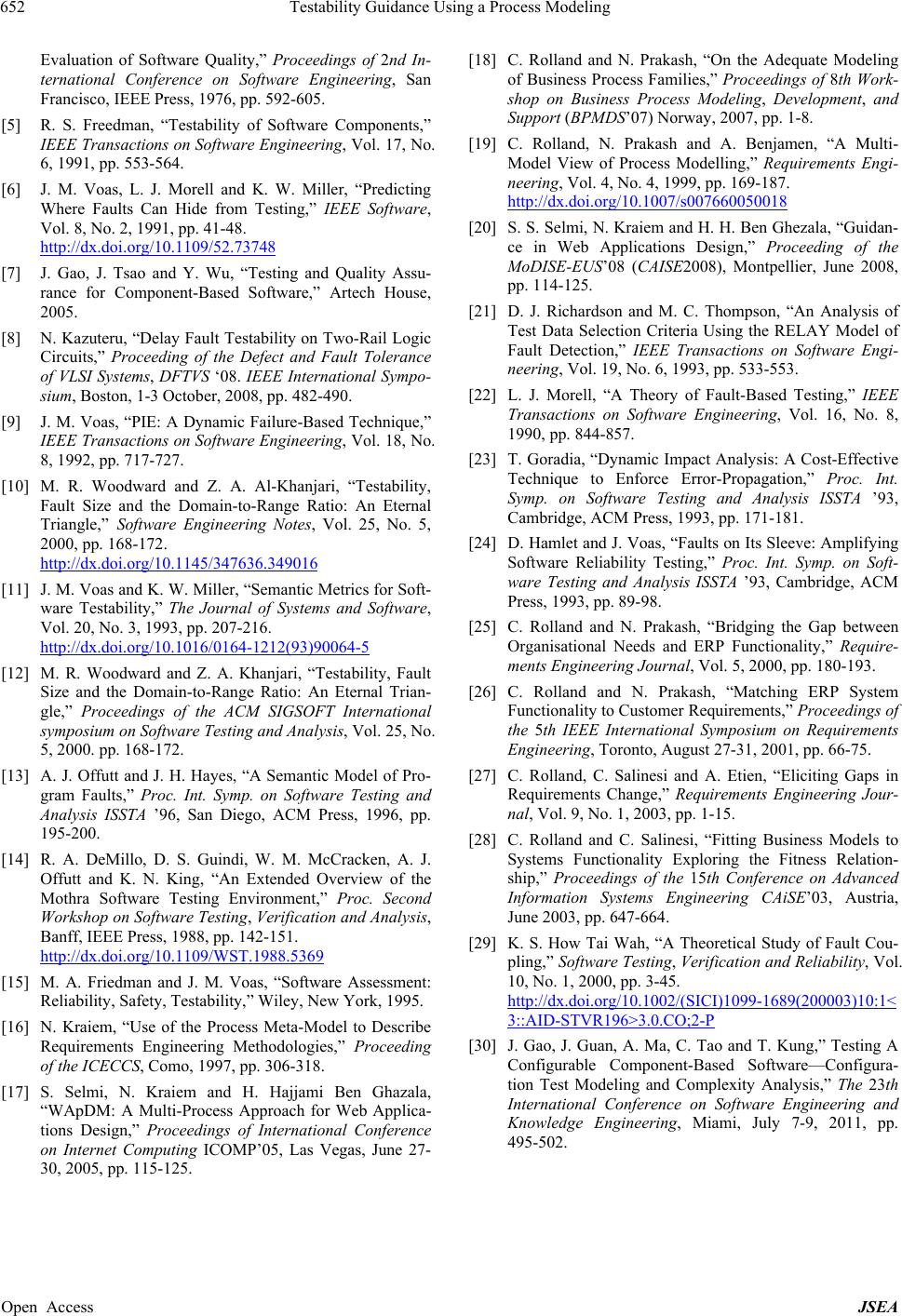
Testability Guidance Using a Process Modeling
652
Evaluation of Software Quality,” Proceedings of 2nd In-
ternational Conference on Software Engineering, San
Francisco, IEEE Press, 1976, pp. 592-605.
[5] R. S. Freedman, “Testability of Software Components,”
IEEE Transactions on Software Engineering, Vol. 17, No.
6, 1991, pp. 553-564.
[6] J. M. Voas, L. J. Morell and K. W. Miller, “Predicting
Where Faults Can Hide from Testing,” IEEE Software,
Vol. 8, No. 2, 1991, pp. 41-48.
http://dx.doi.org/10.1109/52.73748
[7] J. Gao, J. Tsao and Y. Wu, “Testing and Quality Assu-
rance for Component-Based Software,” Artech House,
2005.
[8] N. Kazuteru, “Delay Fault Testability on Two-Rail Logic
Circuits,” Proceeding of the Defect and Fault Tolerance
of VLSI Systems, DFTVS ‘08. IEEE International Sympo-
sium, Boston, 1-3 October, 2008, pp. 482-490.
[9] J. M. Voas, “PIE: A Dynamic Failure-Based Technique,”
IEEE Transactions on Software Engineering, Vol. 18, No.
8, 1992, pp. 717-727.
[10] M. R. Woodward and Z. A. Al-Khanjari, “Testability,
Fault Size and the Domain-to-Range Ratio: An Eternal
Triangle,” Software Engineering Notes, Vol. 25, No. 5,
2000, pp. 168-172.
http://dx.doi.org/10.1145/347636.349016
[11] J. M. Voas and K. W. Miller, “Semantic Metrics for Soft-
ware Testability,” The Journal of Systems and Software,
Vol. 20, No. 3, 1993, pp. 207-216.
http://dx.doi.org/10.1016/0164-1212(93)90064-5
[12] M. R. Woodward and Z. A. Khanjari, “Testability, Fault
Size and the Domain-to-Range Ratio: An Eternal Trian-
gle,” Proceedings of the ACM SIGSOFT International
symposium on Software Testing and Analysis, Vol. 25, No.
5, 2000. pp. 168-172.
[13] A. J. Offutt and J. H. Hayes, “A Semantic Model of Pro-
gram Faults,” Proc. Int. Symp. on Software Testing and
Analysis ISSTA ’96, San Diego, ACM Press, 1996, pp.
195-200.
[14] R. A. DeMillo, D. S. Guindi, W. M. McCracken, A. J.
Offutt and K. N. King, “An Extended Overview of the
Mothra Software Testing Environment,” Proc. Second
Workshop on Software Testing, Verification and Analysis,
Banff, IEEE Press, 1988, pp. 142-151.
http://dx.doi.org/10.1109/WST.1988.5369
[15] M. A. Friedman and J. M. Voas, “Software Assessment:
Reliability, Safety, Testability,” Wiley, New York, 1995.
[16] N. Kraiem, “Use of the Process Meta-Model to Describe
Requirements Engineering Methodologies,” Proceeding
of the ICECCS, Como, 1997, pp. 306-318.
[17] S. Selmi, N. Kraiem and H. Hajjami Ben Ghazala,
“WApDM: A Multi-Process Approach for Web Applica-
tions Design,” Proceedings of International Conference
on Internet Computing ICOMP’05, Las Vegas, June 27-
30, 2005, pp. 115-125.
[18] C. Rolland and N. Prakash, “On the Adequate Modeling
of Business Process Families,” Proceedings of 8th Work-
shop on Business Process Modeling, Development, and
Support (BPMDS’07) Norway, 2007, pp. 1-8.
[19] C. Rolland, N. Prakash and A. Benjamen, “A Multi-
Model View of Process Modelling,” Requirements Engi-
neering, Vol. 4, No. 4, 1999, pp. 169-187.
http://dx.doi.org/10.1007/s007660050018
[20] S. S. Selmi, N. Kraiem and H. H. Ben Ghezala, “Guidan-
ce in Web Applications Design,” Proceeding of the
MoDISE-EUS’08 (CAISE2008), Montpellier, June 2008,
pp. 114-125.
[21] D. J. Richardson and M. C. Thompson, “An Analysis of
Test Data Selection Criteria Using the RELAY Model of
Fault Detection,” IEEE Transactions on Software Engi-
neering, Vol. 19, No. 6, 1993, pp. 533-553.
[22] L. J. Morell, “A Theory of Fault-Based Testing,” IEEE
Transactions on Software Engineering, Vol. 16, No. 8,
1990, pp. 844-857.
[23] T. Goradia, “Dynamic Impact Analysis: A Cost-Effective
Technique to Enforce Error-Propagation,” Proc. Int.
Symp. on Software Testing and Analysis ISSTA ’93,
Cambridge, ACM Press, 1993, pp. 171-181.
[24] D. Hamlet and J. Voas, “Faults on Its Sleeve: Amplifying
Software Reliability Testing,” Proc. Int. Symp. on Soft-
ware Testing and Analysis ISSTA ’93, Cambridge, ACM
Press, 1993, pp. 89-98.
[25] C. Rolland and N. Prakash, “Bridging the Gap between
Organisational Needs and ERP Functionality,” Require-
ments Engineering Journal, Vol. 5, 2000, pp. 180-193.
[26] C. Rolland and N. Prakash, “Matching ERP System
Functionality to Customer Requirements,” Proceedings of
the 5th IEEE International Symposium on Requirements
Engineering, Toronto, August 27-31, 2001, pp. 66-75.
[27] C. Rolland, C. Salinesi and A. Etien, “Eliciting Gaps in
Requirements Change,” Requirements Engineering Jour-
nal, Vol. 9, No. 1, 2003, pp. 1-15.
[28] C. Rolland and C. Salinesi, “Fitting Business Models to
Systems Functionality Exploring the Fitness Relation-
ship,” Proceedings of the 15th Conference on Advanced
Information Systems Engineering CAiSE’03, Austria,
June 2003, pp. 647-664.
[29] K. S. How Tai Wah, “A Theoretical Study of Fault Cou-
pling,” Software Testing, Verification and Reliability, Vol.
10, No. 1, 2000, pp. 3-45.
http://dx.doi.org/10.1002/(SICI)1099-1689(200003)10:1<
3::AID-STVR196>3.0.CO;2-P
[30] J. Gao, J. Guan, A. Ma, C. Tao and T. Kung,” Testing A
Configurable Component-Based Software—Configura-
tion Test Modeling and Complexity Analysis,” The 23th
International Conference on Software Engineering and
Knowledge Engineering, Miami, July 7-9, 2011, pp.
495-502.
Open Access JSEA